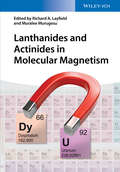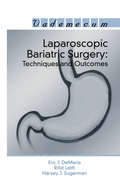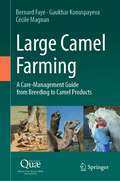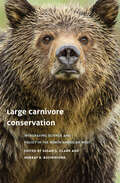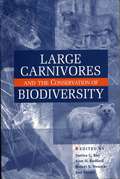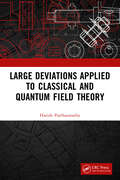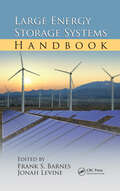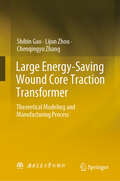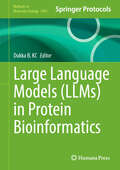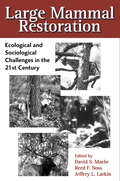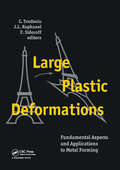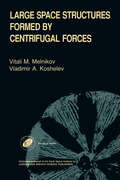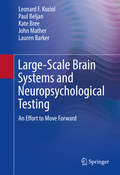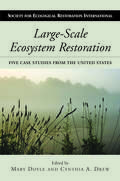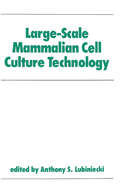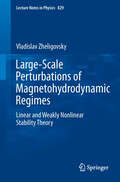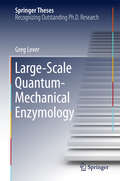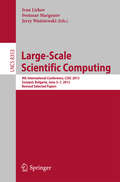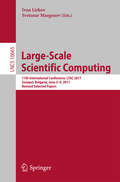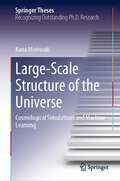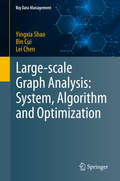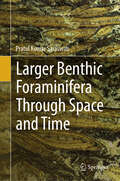- Table View
- List View
Lanthanide-Doped Luminescent Nanomaterials
by Xueyuan Chen Yongsheng Liu Datao TuLanthanide-Doped Luminescent Nanomaterials reviews the latest advances in the development of lanthanide-doped luminescent inorganic nanoparticles for potential bioapplications. This book covers the chemical and physical fundamentals of these nanoparticles, such as the controlled synthesis methodology, surface modification chemistry, optical physics, and their promising applications in diverse bioassays, with an emphasis on heterogeneous and homogeneous in-vitro biodetection of tumor biomarkers. This book is intended for those readers who are interested in systematically understanding the materials design strategy, optical behavior of lanthanide ions, and practical bioapplications of lanthanide nanoparticles. It primarily focuses on the interdisciplinary frontiers in chemistry, physics and biological aspects of luminescent nanomaterials. All chapters were written by scientists active in this field and for a broad audience, providing both beginners and advanced researchers with comprehensive information on the subject. Xueyuan Chen is a Professor at Fujian Institute of Research on the Structure of Matter (FJIRSM), Chinese Academy of Sciences. Yongsheng Liu is a Research Associate Professor at FJIRSM, Chinese Academy of Sciences. Datao Tu is a Research Assistant Professor at FJIRSM, Chinese Academy of Sciences.
Lanthanides and Actinides in Molecular Magnetism
by Muralee Murugesu Richard LayfieldThe first reference on this rapidly growing topic provides an essential up-to-date guide to current and emerging trends.A group of international experts has been carefully selected by the editors to cover all the central aspects, with a focus on molecular species while also including industrial applications.The resulting unique overview is a must-have for researchers, both in academia and industry, who are entering or already working in the field.
Laparoscopic Bariatric Surgery: Techniques and Outcomes
by Eric J. DeMariaThere is no more technically demanding laparoscopic procedure than laparoscopic proximal gastric bypass. Furthermore, training and skill in advanced laparoscopy are inadequate background for developing a program since the bariatric patient presents many complex issues in management for the surgeon. Thus, the novice must master the skills of two disciplines: advanced laparoscopy and bariatric surgical care. The authors bring forward their significant experience in bariatric surgery and lessons learned from the development of their laparoscopic obesity surgery program in order to provide a resource to surgeons committed to bringing safe and effective laparoscopic treatment to their morbidly obese patients.
Large Camel Farming: A Care-Management Guide from Breeding to Camel Products
by Bernard Faye Gaukhar Konuspayeva Cécile MagnanThis practical guide is intended for all actors in the sector who work with large camelids, whether in breeding, technical advice or veterinary care. It successively describes the general aspects of the species, the physiological bases of reproduction, lactation and feeding, the main production processes, and health and hygiene management in camel breeding. Chapters on slaughter, important camel products and their processing complete the volume.Large camels (camels and Bactrian camels) are domestic animals that are increasingly used in Western countries, as well as in Africa and Asia, for tourism, sport, and production of milk, meat, and wool. In addition, camel husbandry systems are changing, taking a greater share of sedentary systems, specializing in breeding, and intensifying production. At the same time, many veterinarians and breeders are not familiar with the animal, its needs, physiology, diseases, and management, which is often based on practices introduced for cattle and proving ineffective.This work is a practical aid for all interested readers who want to embark on the adventure of working with large camelids in a cultural context where they are not yet a dominant element of the agricultural landscape. The numerous photographs and drawings that support the text make it a unique and entertaining read.
Large Carnivore Conservation: Integrating Science and Policy in the North American West
by Susan G. Clark Douglas Clark D. Scott Slocombe David J. Mattson Rebecca Watters Avery C. Anderson Linaya Workman William M. Pym Micheal L. Gibeau Seth M. Wilson Gregory A. Neudecker James J. Jonkel J. Daniel Oppenheimer Lauren Richie David N. Cherney Christina MilloyStrategies for protecting wolves, mountain lions, and more—by taking the human species into account as well: &“Very valuable.&”—Journal of Wildlife Management Drawing on six case studies of wolf, grizzly bear, and mountain lion conservation in habitats stretching from the Yukon to Arizona, Large Carnivore Conservation argues that conserving and coexisting with large carnivores is as much a problem of people and governance—of reconciling diverse and sometimes conflicting values, perspectives, and organizations, and of effective decision making in the public sphere—as it is a problem of animal ecology and behavior. By adopting an integrative approach, editors Susan G. Clark and Murray B. Rutherford seek to examine and understand the interrelated development of conservation science, law, and policy, as well as how these forces play out in courts, other public institutions, and the field. In combining real-world examples with discussions of conservation and policy theory, Large Carnivore Conservation not only explains how traditional management approaches have failed to meet the needs of all parties, but also highlights examples of innovative, successful strategies and provides practical recommendations for improving future conservation efforts. &“Building on decades of work, this book integrates biological knowledge with human dimensions study and charts a course for coexistence with large carnivores.&”—Douglas W. Smith, Senior Wildlife Biologist, Yellowstone National Park
Large Carnivores and the Conservation of Biodiversity
by Joel Berger Justina Ray Robert Steneck Kent H. RedfordLarge Carnivores and the Conservation of Biodiversity brings together more than thirty leading scientists and conservation practitioners to consider a key question in environmental conservation: Is the conservation of large carnivores in ecosystems that evolved with their presence equivalent to the conservation of biological diversity within those systems? Building their discussions from empirical, long-term data sets, contributors including James A. Estes, David S. Maehr, Tim McClanahan, AndrFs J. Novaro, John Terborgh, and Rosie Woodroffe explore a variety of issues surrounding the link between predation and biodiversity: What is the evidence for or against the link? Is it stronger in marine systems? What are the implications for conservation strategies? Large Carnivores and the Conservation of Biodiversity is the first detailed, broad-scale examination of the empirical evidence regarding the role of large carnivores in biodiversity conservation in both marine and terrestrial ecosystems. It contributes to a much more precise and global understanding of when, where, and whether protecting and restoring top predators will directly contribute to the conservation of biodiversity. Everyone concerned with ecology, biodiversity, or large carnivores will find this volume a unique and thought-provoking analysis and synthesis.
Large Deviations Applied to Classical and Quantum Field Theory
by Harish ParthasarathyThis book deals with a variety of problems in Physics and Engineering where the large deviation principle of probability finds application. Large deviations is a branch of probability theory dealing with approximate computation of the probabilities of rare events. It contains applications of the LDP to pattern recognition problems like analysis of the performance of the EM algorithm for optimal parameter estimation in the presence of weak noise, analysis and control of non-Abelian gauge fields in the presence of noise, and quantum gravity wherein we are concerned with perturbation to the quadratic component of the Einstein-Hilbert Hamiltonian caused by higher order nonlinear terms in the position fields and their effect on the Gibbs statistics and consequently quantum probabilities of events computed using the quantum Gibbs state. The reader will also find in this book applications of LDP to quantum filtering theory as developed by Belavkin based on the celebrated Hudson-Parthasarathy quantum stochastic calculus. Print edition not for sale in South Asia (India, Sri Lanka, Nepal, Bangladesh, Pakistan and Bhutan).
Large Energy Storage Systems Handbook (Mechanical and Aerospace Engineering Series)
by Frank S. Barnes Jonah G. LevineIn the current push to convert to renewable sources of energy, many issues raised years ago on the economics and the difficulties of siting energy storage are once again being raised today. When large amounts of wind, solar, and other renewable energy sources are added to existing electrical grids, efficient and manageable energy storage becomes a
Large Energy-Saving Wound Core Traction Transformer: Theoretical Modeling and Manufacturing Process
by Shibin Gao Lijun Zhou Chenqingyu ZhangThis book delves into the innovative realm of wound core transformers designed for high-voltage power grids, moving beyond the traditional laminated core structures prone to magnetic flux leakage and energy dissipation. Through a novel enclosed wound core design that eliminates joints and corners, it presents a transformative approach that minimizes leakage and enhances the electromagnetic performance of transformers. This book not only addresses the technical challenges and solutions in transformer design but also marks a significant step forward in the pursuit of energy efficiency and performance optimization in electrical power systems. Targeting a specialized audience of professors, scholars, and graduate students engaged in transformer energy-saving optimization and related research fields, it offers an in-depth exploration of the complete loss calculation, innovative manufacturing processes, and testing technologies of large-scale wound core transformers.
Large Herbivores (World of Animals: Mammals #5)
by Pat Morris Amy-Jane BeerThis book offers a detailed introduction to large plant eaters, including elephants, rhinos, hippos, horses and zebras, camels and llamas, pigs and peccaries and tapirs. Introduces the animals habitat, status, scientific name, and fascinating facts about each.
Large Language Models (Methods in Molecular Biology #2941)
by Dukka B. KcThis book presents a comprehensive collection of methods, resources, and studies that use large language models (LLMs) in the field of protein bioinformatics. Reflecting the swift pace of LLM development today, the volume delves into numerous LLM-based tools to investigate proteins science, from protein language models to the prediction of protein-ligand binding sites. Written for the highly successful Methods in Molecular Biology series, chapters include the kind of detailed implementation advice to ensure success in future research. Authoritative and practical, Large Language Models (LLMs) in Protein Bioinformatics serves as an ideal guide for scientists seeking to tap into the potential of artificial intelligence in this vital area of biological study.
Large Mammal Restoration: Ecological And Sociological Challenges In The 21St Century
by David Maehr Jeffery L. Larkin Melvin E. Sunquist Reed F. NossEvidence is mounting that top carnivores and other large mammals play a pivotal role in regulating ecosystem health and function, yet those are the species that are most likely to have been eliminated by past human activities. In recent decades, numerous efforts have been undertaken to return some of the species that were previously extirpated on local or regional scales.Large Mammal Restoration brings together for the first time detailed case studies of those efforts, from restoring elk in Appalachia to returning bison herds to the Great Plains to the much-publicized effort to bring back the gray wolf to Yellowstone National Park. Together these case studies offer important lessons and new ways of thinking for wildlife managers and conservation biologists involved with restoration programs. Sections examine: approaches to determining the feasibility of a restoration program critical hands-on aspects of restoring large mammals obtaining public input into the process and gaining community support for programs the potential of some species to return without direct human intervention, and what can be done to facilitate that natural colonization An introductory chapter by Reed F. Noss explores some of the reasons for restoring large mammals, as well as some of the ecological and social complications, and a concluding overview by David S. Maehr discusses the evolutionary importance of large mammal restoration. Contributors include Paul C. Paquet, Barbara Dugelby, Steven H. Fritts, Paul R. Krausman, Larry D. Harris, Johnna Roy, and many others. Large Mammal Restoration brings together in a single volume essential information on the lessons learned from previous efforts, providing an invaluable resource for researchers and students of conservation biology and wildlife management as well as for policymakers, restoration advocates, and others involved with the planning or execution of a restoration program.
Large Plastic Deformations: Proceedings of the international seminar MECAMAT'91, Fontainebleau, France, 7-9 August 1991
by C.TEODOSIU; J.L.RAPHANEL; F.SIDOROFFThis volume covers topics involving large plastic deformation of metallic materials. These proceedings offer an overview of the synergism achieved by combining microstructural characterization and understanding, mechanical modelling and experiments, numerical analysis and computation.
Large Space Structures Formed by Centrifugal Forces
by V A Koshelev V M MelnikovThis book describes a feasible means of constructing such a reflector, as well as simple, reliable and low-cost structures for television and radio transmissions, debris removal from space and the development of solar sails for interplanetary missions. The aim of this book is thus to provide a comprehensive overview of the research in the technology of such space based structures expanded by centrifugal forces. The most promising concepts and design solutions for different applications are addressed. Particular emphasis is placed on deployment dynamics of space-based structures and their retrieval techniques: the reorientation of expanded film sheets in space, selecting film folding patterns, tethering systems, and deployment mechanisms, and controlling the deployment-retrieval process by space vehicles. Also featured are sections on ground and orbital simulation.
Large Turbo-Generators: Malfunctions and Symptoms (Ieee Press Series On Power Engineering Ser. #38)
by Isidor Kerszenbaum Geoff KlempnerThis book presents a comprehensive, ordered relationship between malfunctions and symptoms occurring in large turbogenerators. With this book, the operator and/or engineer in a generating station could identify underlying causes of a developing component degradation or a failure quicker, which could potentially save both time and money and reduce the trial-and-error troubleshooting process. Large turbogenerators are the most important source of electricity. They can be found in thousands of power stations in every country. Forced outages, failures and degradation of these very expensive machines have an enormous aggregate cost to society. As such, any tool that can ameliorate loss of production by shaving time from troubleshooting activities, and avoiding unnecessary costs by detecting and promptly responding to component degradation, represents a step forward.
Large-Scale Brain Systems and Neuropsychological Testing
by Paul Beljan John Mather Leonard F. Koziol Kate Bree Lauren BarkerThis leading-edge volume offers a new framework forneuropsychological testing rooted in the current evidence base on large-scalebrain system interactions. Expert coverage brings traditional discrete areas ofcognitive functioning (e. g. , attention, memory) in line with highly nuancedrelationships between cortical and subcortical processing. The new findingspoint to more accurate and targeted testing, as authors expand on the judiciousaddition of nonstandardized methods to core diagnostic tools and the underusedcapacity of neuropsychological testing to assess social behavior andpersonality. The book's emphasis on cognition in context gives practitioners betterunderstanding of assessment and evaluation, leading to improved diagnosis,treatment, and outcomes for individuals as well as significant improvements inthe field. This innovative reference: Reframes cognitive functioning in light of current data on brain interconnectivity. Critiques current methods of neuropsychological test interpretation. Reviews known, useful interpretive methodologies within a new context. Features instructive case examples emphasizing accurate historical and test data. Revisits the strengths and limitations of the bell curve construct. Examines the interpretive significance of pathognomonic signs. Details strategies for making neuropsychological evaluations more clinically relevant. Large-Scale Brain Systems and NeuropsychologicalTesting combines current findings, clinicalsense, and common sense to ground neuropsychologists, school psychologists,child psychologists, and clinical social workers in the effective assessment ofreal-world functioning.
Large-Scale Ecosystem Restoration: Five Case Studies from the United States (Science Practice Ecological Restoration)
by Cynthia Drew Mary DoyleLarge-Scale Ecosystem Restoration presents case studies of five of the most noteworthy large-scale restoration projects in the United States: Chesapeake Bay, the Everglades, California Bay Delta, the Platte River Basin, and the Upper Mississippi River System. These projects embody current efforts to address ecosystem restoration in an integrative and dynamic manner, at large spatial scale, involving whole (or even multiple) watersheds, and with complex stakeholder and public roles. Representing a variety of geographic regions and project structures, the cases shed light on the central controversies that have marked each project, outlining * the history of the project * the environmental challenges that generated it * the difficulties of approaching the project on an ecosystem-wide basis * techniques for conflict resolution and consensus building * the ongoing role of science in decision making * the means of dealing with uncertainties A concluding chapter offers a guide to assessing the progress of largescale restoration projects. Large-Scale Ecosystem Restoration examines some of the most difficult and important issues involved in restoring and protecting natural systems. It is a landmark publication for scientists, policymakers, and anyone working to protect or restore landscapes or watersheds.
Large-Scale Mammalian Cell Culture Technology (Biotechnology And Bioprocessing Ser. #10)
by LubinieckiAn interdisciplinary approach, integrating biochemistry, biology, genetics, and engineering for the effective production of protein pharmaceuticals. The volume offers a biological perspective of large-scale animal cell culture and examines diverse processing strategies, process management, regulator
Large-Scale Perturbations of Magnetohydrodynamic Regimes
by Vladislav ZheligovskyNew developments for hydrodynamical dynamo theory have been spurred by recent evidence of self-sustained dynamo activity in laboratory experiments with liquid metals. The emphasis in the present volume is on the introduction of powerful mathematical techniques required to tackle modern multiscale analysis of continous systems and there application to a number of realistic model geometries of increasing complexity. This introductory and self-contained research monograph summarizes the theoretical state-of-the-art to which the author has made pioneering contributions.
Large-Scale Quantum-Mechanical Enzymology
by Greg LeverThis work establishes linear-scaling density-functional theory (DFT) as a powerful tool for understanding enzyme catalysis, one that can complement quantum mechanics/molecular mechanics (QM/MM) and molecular dynamics simulations. The thesis reviews benchmark studies demonstrating techniques capable of simulating entire enzymes at the ab initio quantum-mechanical level of accuracy. DFT has transformed the physical sciences by allowing researchers to perform parameter-free quantum-mechanical calculations to predict a broad range of physical and chemical properties of materials. In principle, similar methods could be applied to biological problems. However, even the simplest biological systems contain many thousands of atoms and are characterized by extremely complex configuration spaces associated with a vast number of degrees of freedom. The development of linear-scaling density-functional codes makes biological molecules accessible to quantum-mechanical calculation, but has yet to resolve the complexity of the phase space. Furthermore, these calculations on systems containing up to 2,000 atoms can capture contributions to the energy that are not accounted for in QM/MM methods (for which the Nobel prize in Chemistry was awarded in 2013) and the results presented here reveal profound shortcomings in said methods.
Large-Scale Scientific Computing
by Ivan Lirkov Svetozar Margenov Jerzy WaśniewskiThis book constitutes the thoroughly refereed post-conference proceedings of the 9th International Conference on Large-Scale Scientific Computations, LSSC 2013, held in Sozopol, Bulgaria, in June 2013. The 74 revised full papers presented together with 5 plenary and invited papers were carefully reviewed and selected from numerous submissions. The papers are organized in topical sections on numerical modeling of fluids and structures; control and uncertain systems; Monte Carlo methods: theory, applications and distributed computing; theoretical and algorithmic advances in transport problems; applications of metaheuristics to large-scale problems; modeling and numerical simulation of processes in highly heterogeneous media; large-scale models: numerical methods, parallel computations and applications; numerical solvers on many-core systems; cloud and grid computing for resource-intensive scientific applications.
Large-Scale Scientific Computing
by Ivan Lirkov Svetozar MargenovThepapersinthis volumewerepresentedatthe4thInternationalConferenceon Large-Scale Scienti'c Computations ICLSSC 2003. It was held in Sozopol, B- garia, June 4-8, 2003. The conference was organized and sponsored by the C- tral Laboratory for Parallel Processing at the Bulgarian Academy of Sciences. Support was also provided from the Center of Excellence "BIS 21" (funded by the European Commission), SIAM and GAMM. A co-organizer of this tra- tional scienti'c meeting was the Division of Numerical Analysis and Statistics of the University of Rousse. The success of the conference and the present volume in particular are the outcome of the joint e'orts of many colleagues from various institutions and organizations. First thanks to all the members of the Scienti'c Committee for their valuable contribution to forming the scienti'c face of the conference, as well as for their help in reviewing contributed papers. We would like to specially thank the organizers of the special sessions: R. Blaheta, N. Dimitrova, A. Ebel, K. Georgiev, O. Iliev, A. Karaivanova, H. Kosina, M. Krastanov, U. Langer, P. Minev, M. Neytcheva, M. Sch] afer, V. Veliov, and Z. Zlatev. We are also grateful to the sta? involved in the local organization. Special Events: - The conference was devoted to the 60th anniversary of Raytcho Lazarov. - During the conference, the nomination for the World Level of the Hall of Fame for Engineering, Science and Technology, HOFEST, was o'cially awarded to Owe Axelsson.
Large-Scale Structure of the Universe: Cosmological Simulations and Machine Learning (Springer Theses)
by Kana MoriwakiLine intensity mapping (LIM) is an observational technique that probes the large-scale structure of the Universe by collecting light from a wide field of the sky. This book demonstrates a novel analysis method for LIM using machine learning (ML) technologies. The author develops a conditional generative adversarial network that separates designated emission signals from sources at different epochs. It thus provides, for the first time, an efficient way to extract signals from LIM data with foreground noise. The method is complementary to conventional statistical methods such as cross-correlation analysis. When applied to three-dimensional LIM data with wavelength information, high reproducibility is achieved under realistic conditions. The book further investigates how the trained machine extracts the signals, and discusses the limitation of the ML methods. Lastly an application of the LIM data to a study of cosmic reionization is presented. This book benefits students and researchers who are interested in using machine learning to multi-dimensional data not only in astronomy but also in general applications.
Large-scale Graph Analysis: System, Algorithm and Optimization (Big Data Management)
by Bin Cui Lei Chen Yingxia ShaoThis book introduces readers to a workload-aware methodology for large-scale graph algorithm optimization in graph-computing systems, and proposes several optimization techniques that can enable these systems to handle advanced graph algorithms efficiently. More concretely, it proposes a workload-aware cost model to guide the development of high-performance algorithms. On the basis of the cost model, the book subsequently presents a system-level optimization resulting in a partition-aware graph-computing engine, PAGE. In addition, it presents three efficient and scalable advanced graph algorithms – the subgraph enumeration, cohesive subgraph detection, and graph extraction algorithms. This book offers a valuable reference guide for junior researchers, covering the latest advances in large-scale graph analysis; and for senior researchers, sharing state-of-the-art solutions based on advanced graph algorithms. In addition, all readers will find a workload-aware methodology for designing efficient large-scale graph algorithms.
Larger Benthic Foraminifera Through Space and Time
by Pratul Kumar SaraswatiForaminifera are single-celled marine organisms, usually less than a millimeter in size, and their fossil records extend back in geological time some 500 million years. Some foraminifera have grown to over 10 centimeters; these are informally called "larger benthic Foraminifera" (LBF). LBF are of outstanding value in field and in laboratory experiments. They can serve as geochemical proxies and can be used to learn about biology, biomineralization process, and more. Their study finds wide-ranging geological applications, including the carbonate platforms' past environmental changes and stratigraphy. There are many books on micropaleontology, fewer on Foraminifera and practically none on LBF. The ones that do exist are generally too specialized for micropaleontology and carbonate sedimentology doctoral students to utilize. This volume aims to fill this gap by providing readers with an understanding of the morphology and distribution of LBF in space (environment) and time (evolution). In addition, the isotope and trace metal proxies in LBF are discussed for paleoclimate reconstruction. This volume will benefit researchers and professionals in micropaleontology, hydrocarbon exploration, carbonate sedimentology, and paleoclimate.

